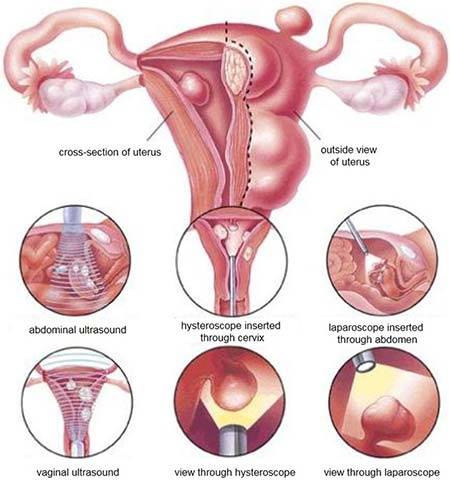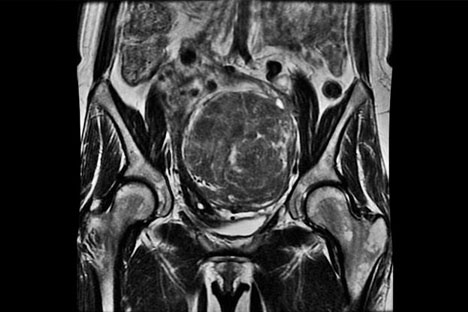Myomectomy
 A myomectomy is the procedure in which your gynecologist in Midtown specialist removes fibroids, or, benign muscular growths on the inside, in the walls, on the outside, or a combination of either, from your uterus. Your gynecologist may perform these procedure in several different manners such as hysteroscopically (with a small camera), open technique, also called a laparotomy, with the assistance of a robot, or laparoscopically (with small cameras but through the abdomen) if you have abnormal bleeding patterns that may or may not be accompanied by infertility issues as well. Broken down:
A myomectomy is the procedure in which your gynecologist in Midtown specialist removes fibroids, or, benign muscular growths on the inside, in the walls, on the outside, or a combination of either, from your uterus. Your gynecologist may perform these procedure in several different manners such as hysteroscopically (with a small camera), open technique, also called a laparotomy, with the assistance of a robot, or laparoscopically (with small cameras but through the abdomen) if you have abnormal bleeding patterns that may or may not be accompanied by infertility issues as well. Broken down:
- A hysteroscopy is the process of looking into your uterus with a small camera instrument called a hysteroscope.
- Myomectomy means the removal of myomas (fibroid growths inside or on the uterus).
- Polypectomy is the removal of polyps (benign growths, like skin tags, on the inside of the uterus).
Size and location are the two most important considerations when deciding how to address a fibroid
Whether you have a myomectomy vs hysterectomy will result in very different outcomes. The myomectomy removes only fibroids; your uterus remains entirely intact. During a hysterectomy, your reproductive organs are removed, often including your fallopian tubes, ovaries and all or part of your womb. One of the main reasons to get a hysteroscopic myomectomy/polypectomy is to determine which procedure you need.
Risk Factors
You may be a candidate for hysteroscopic myomectomy/polypectomy — and at risk for uterine polyps or fibroids that lead to abnormal bleeding — if your symptoms don’t respond to more conservative treatments. Other reasons to undergo the procedure include if you:
- Are on tamoxifen therapy for breast cancer treatment
- Have had polyps in other reproductive organs
- Have chronic bleeding following sex
- Experience continuous, chronic vaginal discharges
- Have dysmenorrhea or abnormally painful menstrual cycles
- May have polyps that are preventing you from getting pregnant
How to Prepare for the Test
While the procedure is minimally invasive, you may be put under general anesthesia for abdominal, robotic, laparoscopic and for other types of hysteroscopic myomectomies. Conversely, you may just receive a localized spinal anesthetic that numbs the lower half of your body. This is recommended for certain hysteroscopic myomectomies.
If your gynecologist in Midtown decides on general anesthesia, you can expect to be out for about 15 to 30 minutes. You’ll be asked to stop eating and drinking at least 12 hours before your procedure. Additionally, tell your gynecologist about any medications you may be taking, including herbs, supplements and other over-the-counter medications, such as vitamins and pain relievers. You’ll most likely need to discontinue their use until after the procedure. It is especially important to tell your doctor if you are taking any blood pressure medications, blood thinners, diabetes drugs, or seizure medications, prior to schedulaing the procedure or surgery.
While a hysteroscopic myomectomy/polypectomy is typically performed on an outpatient basis, you may have to be hospitalized for the procedure.
- An open myomectomy, performed through your abdominal cavity, usually requires a two-to-three-day hospital stay.
- A robotic myomectomy or one done with a laparoscopic usually requires just an overnight stay.
Laparoscopic Myomectomy vs Abdominal Myomectomy
Whenever possible, your gynecologist, will choose the least invasive procedure, which in this case is the laparoscopic myomectomy. It requires only a tiny incision, made near your navel, though which your surgeon inserts a long, thin tube with a light and a camera on the end. Another tube is then inserted through the first tube. That one holds the instruments that do the fibroid scraping.
On the other hand, an abdominal myomectomy, also called a laparotomy, requires that a larger incision be made across your abdomen to access your uterus. This procedure gives your Midtown gynecologist greater access to view your uterus and remove large fibroids.
Risks for both kinds of procedures include:
- Excessive loss of blood
- Adhesions on the outside wall of your uterus that could lead to further complications
- Weakening of your uterine walls that could cause complications during a future pregnancy
- The rare chance that you may have to have a hysterectomy if bleeding occurs that can’t be stopped
What to Expect from Vaginal Myomectomy

Once you’ve been prepped and moved into a surgical suite in the gynecology New York office or hospital:
- Your cervix is dilated with a sterile saline solution to expand the area and give the surgeon room to visually inspect your reproductive organs.
- Tissue is cut, usually with a laser through your vagina and your uterus into the cervix, to retract it appropriately.
- Pieces of the fibroids are shaved off so that they don’t protrude and are even with the rest of the tissue lining your cervix.
- Polyps are completely removed, with a sharp pincer-type instrument attached to a long, thin, lighted tube. The area may be lightly cauterized to stop any bleeding.
- Once the instruments are removed, your cervix is lightly rinsed with the fluid that was used to expand your cervix. With it, excess tissues from the fibroids are washed out.
Once you leave the office or hospital, you’ll be provided a mild pain reliever. Follow the directions for after-care that you receive, such as:
- Resume normal eating habits immediately
- Avoid tampon use for at least two or three days
- Refuse sexual intercourse until all the bleeding has stopped completely
- Only take showers, no baths, until the bleeding has completely stopped
- Use a hot water bottle or pain medication when you feel uncomfortable cramping, which is to be expected for a few days
- Plan to avoid driving for at least 24 hours
- Get back into your normal daily routines as soon as you feel able, unless your doctor advises you otherwise
Hysteroscopic Myomectomy Complications
It’s important that your gynecological surgeon remove all polyps found because those tend to be the culprits that lead to cancer. Removing benign polyps is an important step in allaying any signs of cancer early on.
Complications from the procedure are rare, but they do exist. Some potential aside effects of myomectomy/polypectomy include:
- Excessive bleeding after the procedure. This may be particularly prevalent if the reason for the procedure in the first place was heavy bleeding. While your gynecologist Midtown takes extra precautions to prevent excess bleeding, you may be directed to take steps to build your blood count up before the procedure.
- A hysteroscopic myomectomy may affect a future pregnancy if your uterine walls are weakened by any incisions made during the procedure. You may have to undergo a cesarean section or C-section to avoid further complications. Additionally, the very presence of uterine fibroids is often associated with complications during pregnancy.
- Scar tissue sometimes forms in the spots where incisions were made. Scar tissue forming outside the uterus can lead to a blocked fallopian tube or problems with your intestines becoming looped. Adhesions rarely form inside the uterus, but if they do, you could develop Asherman’s syndrome, which causes infertility.
- Hysterectomy is another extremely rare complication. It results from a finding of severe abnormalities in your uterus or if bleeding becomes uncontrollable while you are having the procedure done.
- Cancerous tumors can be spread during this procedure, although this too is a rare complication. It’s more common in post-menopausal women. It’s caused by tumors being mistaken for fibroids and being shaved into little pieces that then travel through your body and multiply.
Myomectomy Recovery Times and Outcomes
Following a myomectomy, you may feel fatigued and experience higher pain levels for a couple days. After a laparoscopic procedure, you should be able to walk out of the hospital on your own on the first day. You’ll be back driving in a few days, back to work as soon as you feel ready and back to your normal exercise routines within about two weeks. If the procedure was performed abdominally, you may have to spend the first night in the hospital.
Long-term, your recovery time varies depending on your age and general health, but generally, it takes about two weeks of rest and up to six weeks of slow recovery time following an abdominal myomectomy. You should see your Midtown gynecologist if you have continual bleeding from either procedure.
Valuable Outcomes
Fibroids very rarely turn into cancer, but can still interfere with daily activities
The results from a hysteroscopic myomectomy/polypectomy can lead to drastic improvements in your life. At the same time, once you’ve had fibroids or polyps, you are at a greater risk of getting them again. Immediate benefits include:
- Improved fertility. While your chances of a post-hysteroscopic myomectomy pregnancy are greatly improved, you should wait about three months before trying to get pregnant to give your uterus sufficient time to heal properly.
- Relief from the symptoms that instigated the procedure in the first place, such as excessive bleeding that finally comes under control.
All symptoms should always be evaluated with a thorough consultation and examination by your gynecologist for an accurate diagnosis and treatment plan to exclude any underlying serious condition. The hysteroscopic myomectomy procedure, indications, options, risks/benefits should always be discussed with your gynecologist.
Important Reminder: This information is only intended to provide guidance, not definitive medical advice. Please consult ob/gyn doctor about your specific condition. Only a trained, experienced gynecologist can determine an accurate diagnosis and proper treatment.
Have questions about Hysteroscopic Myomectomy / Polypectomy procedure? Schedule an appointment with an internationally recognized NYC OBGYN doctor, Dr. Fernando Mariz of Manhattan Women’s Health and Wellness, today.
Updated on Jun 26, 2020 by Dr. Fernando Mariz (Gynecologist), Manhattan Women’s Health and Wellness
Best-in-class
New York Gynecology Clinic
Manhattan Specialty Care in the Press

Call now to make an appointment with our highly rated Manhattan Gynecology doctors regarding your health. We look forward to seeing you!
book online now
(212) 378-9987
New York City Locations:
Manhattan Women's Health & Wellness (Upper East Side)
983 Park Ave, Ste 1D17
New York, NY 10028
(212) 389-1904
Manhattan Women's Health & Wellness (Midtown)
51 East 25th St, Ste 451
New York, NY 10010
(212) 677-7654
Manhattan Women's Health & Wellness (Union Square)
55 W 17th St, Ste 104
New York, NY 10011
(212) 378-9985